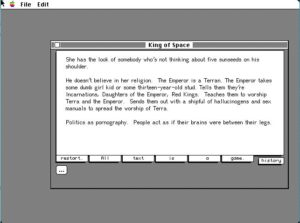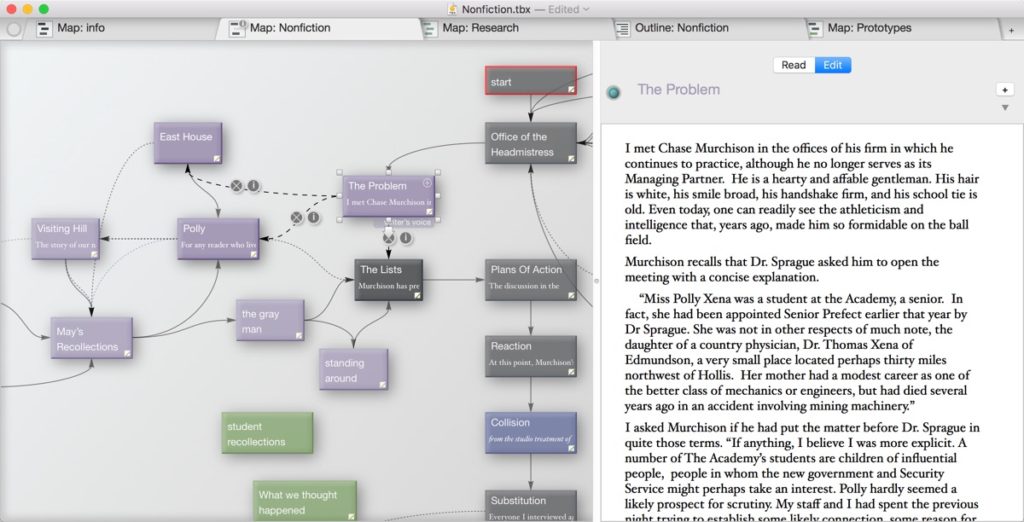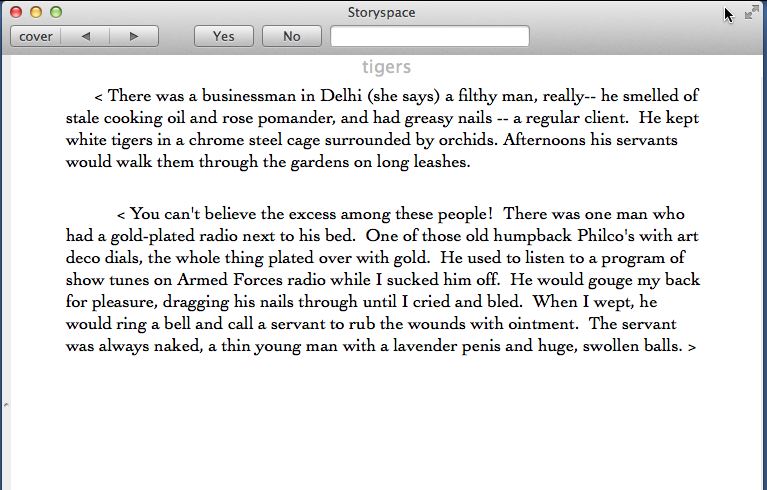The interesting if badly flawed hypertext novel King of Space was born in the late 1980s, when an English professor and aspiring novelist named Sarah Smith met Mark Bernstein of Eastgate Systems at a MacWorld show. “Want to write me something?” Bernstein asked. Smith, who had owned a home computer for ten years already and was a longtime devotee of the text adventures published by Infocom and others, agreed.
At this early date, Bernstein hadn’t yet completed the acquisition of Storyspace, the hypertext-authoring system destined to be the bedrock technology of what I refer to as the Eastgate school. He therefore developed an engine from scratch for Smith’s project, running under HyperCard on the Macintosh; he called it in various places “KingWriter” or “Hypergate.” Smith provided him with the text and the design, and he, with the occasional help of an artist named Matthew Mattingly and a composer named Michael Druzinsky, translated it to the computer.
I ordered King of Space directly from Eastgate some time ago, at the same time that I ordered Michael Joyce’s afternoon, a story for my previous article on the literary movement Eastgate once attempted to foster. It arrived in a simple gray folio containing an instruction booklet and a hand-labelled, obviously hand-burned CD. I would need, the package helpfully informed me, 1 MB of memory and a hard disk in my Macintosh to run it. Given the game’s obscurity even in the days when those minimum system requirements would have been significant, I felt like an intrepid digital explorer, venturing into a realm few had ever visited before me, as I moved the files into a vintage-Mac emulator and began to play.
From the moment that I first turned my attention to the Eastgate school, I had been particularly intrigued by King of Space among the more than forty works of hypertext which they published in their heyday because it lives at the opposite end of a continuum from afternoon, a story and the many similar Eastgate works created in Storyspace. Belying the name of the tool used to create them, those are mostly stateless word salads with little coherent plot or narrative drive. King of Space, by contrast, does have a story it wants to share with you, one which you can guide to some extent by making a series of clearly-delineated choices, much like in a Choose Your Own Adventure novel or a modern choice-based digital interactive fiction. As such, it feels more approachable than was the Eastgate norm to those of us not steeped in the post-structuralist literary theory so many Storyspace works were crafted to illuminate.

King of Space pays homage to Adventure and Zork. One does have to wonder, however, whether most of the academics who were virtually the only ones to play it got the reference.
As the name would imply, King of Space is a science-fiction story. By her own account “a science-fiction fan since the day she got the adult librarian to let her read The Day of the Triffids,” Sarah Smith approaches the genre without contempt, although she does evince a bit of that over-eagerness in her world-building which is so common when “literary” authors make the jump to science fiction. In particular, her story’s introduction is just way, way too dense, the sort of thing you can read five times over and still not make any sense of:
Fifty years ago, Nicholsun’s Plague devastated the Asteroids. The Plague made its victims mindlessly loyal to anyone who gave off a tailored rho-pheromone. Its effects are hereditary. The Terran Empire has quarantined the Asteroids.
Tam Rosse, rebel against the Terrans, has been bred for resistance to the Plague. Escaping from prison, he finds the derelict greatship Lady Nii. The Nii could save his revolution. But to get it, he must fight “King” Brady, the only human aboard the ship, and the ship’s half-mad interface, the Lady Nii herself, Brady’s ally and lover.
Tam Rosse is himself being hunted by the virgin Priestess of Pallas, who emits the rho-pheromone. She needs a lover, bodyguard, and slave. Tam Rosse needs her bioengineering skill.
But the Priestesses of Pallas are part of a fertility cult. To gain her full powers, the Priestess must lose her virginity — and the Plague is spread sexually. How resistant is Tam Rosse? And how resourceful?
Got all that? There will be a quiz later.
Thankfully, it all settles down into a fairly conventional adventure story — at least on the surface — once you get started. You play as Tam Rosse, the aforementioned fugitive from injustice. The lifeboat in which you made your escape is almost out of energy when you come upon the Lady Nii and its inhabitants. Your first task must be to get inside, after which the adventure of exploring a strange spaceship ensues. It’s perfectly possible to approach the whole experience as a sort of high-brow take on Starcross or Rendezvous with Rama.
But of course, this is still an Eastgate work, which means there are agendas at play beyond the space opera at the surface. From Smith’s introductory materials:
For me, the most important writer of “hypermedia” in this century has been James Joyce in Finnegans Wake. King of Space explores two Joycean issues, non-linear narration and sexual mythologies, within the framework of a science-fiction space opera.
Smith then proceeds to describe these two facets of her game, in reverse order from that in which she first listed them. So, let’s begin, as she does, with the “sexual mythologies.”
Mythology of Sex: King of Space deals with the same group of sexual myths depicted in The Golden Bough: the impotent king and the rescue of the land; ritual defloration; depiction of the male as king, lover, protector, but also as persecutor, Bad Father, and rapist; depiction of the female as fertility deity, sex goddess, Castrating Mother, and the land itself. That is, the stories concern myths of female experiences of violence, such as rape, and female rites of passage, such as childbirth, as well as their male equivalents.
It should be clear by now that King of Space is obsessed with sex and reproduction; womb imagery is everywhere in both the text and the occasional illustrations that accompany it. It also seems to be interested in subverting some of the expectations that surround these eternal human concerns. Tam Rosse, cast in the role of the swashbuckling male hero, finds himself struggling to resist the sexual advances of the Priestess. Should he succumb, he faces the loss of his very identity. It isn’t difficult to draw a parallel with the plight of so many women throughout human history, facing marriage as the sublimation of whatever individual identity society currently allows them into the stereotypical roles of wife and mother. (“I haven’t much of my own way at present, but you see, when I’m married I shan’t have it at all,” says Alice Vavasor of her upcoming nuptials in Trollope’s Victorian classic Can You Forgive Her?. “You can’t wonder that I shouldn’t be in a hurry.”)
Yet the archetype of the Priestess, the female sex goddess who is deeply dangerous to men, is of course hardly an uncommon one in myth. This and other references to mythologies of sex are indeed interesting to catalog, but I’m not quite sure what Sarah Smith is really trying to do with them. I’m not sure, in other words, why King of Space should qualify as an exploration of sexual mythologies as opposed to an homage or evocation — a ticking off of the boxes that Smith lists so peremptorily in the extract above. I have no problem with homage, and, indeed, would prefer it to a more polemical approach. It’s just that… well, what, for instance, is the “male equivalent” of childbirth? Smith’s statements about her own work’s premise seems more dashed-off than considered.
And yet the fact does remain that, if we can manage to stop stressing over all this business about sexual mythologies, the story is a reasonably engaging one. I wouldn’t say that Smith’s prose soars, but neither does it conspicuously try to soar and come crashing back to earth like a wingless 747, as is the case for that of so many other writers of the Eastgate school. As a printed novella, it would be a serviceable if less than earth-shattering work of science fiction.
As an interactive work, however, it rather falls down on the job. Let’s consider what Smith herself has to say about this aspect of King of Space.
Non-linear narrative: King of Space has only one story, a rite of passage — not linear because it happens to several people in several ways, but by no means a story without structure. A character needs to undergo a rite; the character makes a choice; the character takes a journey; the character undergoes a test; the character succeeds or fails at the rite. Because this is a computerized novel, some of the choices are given to the reader, and tests are presented as games. Tests and stories lead into one another and are resolved by each other.
King of Space is less well-stocked with choices than a traditional computer game; only a few of the possible stories around these characters are told here. The characters in King of Space are bound by their past and their nature, so that choices they appear to have are blocked. This can be frustrating when you come to it with game-playing expectations — perhaps too frustrating. Let us know.
I find these paragraphs more than a little amusing. I hardly know what to say about the elaborate attempt to justify the mini-games that pop up now and again — more on them momentarily — as “tests” which the character undergoes on his journey; I suspect Smith may have been reading a bit too much Joseph Campbell. The tacit assertion that readers who fail to appreciate works of the Eastgate school do so because they approach them as — gasp! — games would become an all-purpose way of deflecting criticism in academic circles in the years to come. For my own part, I don’t hesitate to call King of Space a “game” because that’s what we as a culture have, for better or for worse, decided to call interactive works like this one. To call it anything else would be to create a false distinction.
So then, writers of narrative games ever since the form’s invention have been coming up with more- or less-compelling justifications for the fact that you can’t just do whatever you want to in their stories. I suppose Smith’s assertion that her characters “are bound by their past and their nature” will do as well as any. But really, Sarah… are you sure it wasn’t because you were working with a very limited hypertext system, and couldn’t build in a lot of real choice without the combinatorial explosion overwhelming you? One of King of Space‘s biggest problems is that it rather forgets that it’s supposed to be an interactive narrative at all for long stretches of time. There are places where a dozen or more screens full of text can go by without you being offered a single choice about anything. Needless to say, this does nothing to foster engagement.

Here we have one of many examples of fake interactivity. You can “look for the air cylinders” until the end of time; the story won’t progress until you “take the software.”
Even when you do appear to have options, it’s often only an appearance of interactivity. King of Space often uses head-fakes dating as far back as the pioneering interactive movie Kinoautomat to keep the story funneling down a manageable pathway. Many — perhaps most — of the choices it presents aren’t really choices at all, yielding little better than a paragraph or two of text whose gist is, “You can’t do that,” and a return to the previous menu. Other choices are accepted, but merge back into a main narrative through-line very quickly.
Still, Smith was more aware than most Eastgate authors of what was going on in the field of mainstream computer games, and you can see this knowledge in her work. Indeed, she has named as one of King of Space‘s main inspirations Thomas M. Disch’s text adventure Amnesia. Given this background, we perhaps shouldn’t be too surprised that, in addition to the branching (or allegedly branching) choices, King of Space is occasionally broken up by the minigames — excuse me, “tests” — which Smith alluded to above. These are a mixed bag — sometimes trivial, sometimes all but impossible. Many of them bear a marked similarity to the puzzles found in The Fool’s Errand, leading me to believe that either Smith or Bernstein — or both — must have played Cliff Johnson’s puzzling classic. Personally, I got completely stymied by a re-implementation of another gaming classic, one that may very well have gotten Eastgate sued had King of Space not remained so very obscure. There comes a point where you’re expected to fend off an attack from enemy spacecraft by playing the most baffling version of Tetris ever created. Slow, awkward, and confusing as all get-out — you’re apparently meant to repair systems on your ship by lining up certain sequences of blocks — this minigame utterly defeated me, preventing me from ever reaching the end of the story. There’s a germ of a good idea in there, but the implementation… well, suffice to say that it needs some work.

This image illustrates some of the endemic sloppiness of King of Space. We’ve been provided with a map of the Lady Nii, albeit one that serves little purpose in this hypertext narrative. (Sarah Smith does often seem like she’d really rather be designing a text adventure.) Note how the text carelessly spills across boundaries and how the map runs off the edge of the (non-sizable) window, as if nobody could be bothered to take the time to get it right.
This leads us to some of the larger questions that surround the Eastgate works in general — questions which have always left the whole enterprise so ripe for charges of disingenuity. The works invariably employ non-standard, non-intuitive interfaces. But is this really, as the apologists claim, out of a wish to jar the reader/player out of her conventional frame of mind, or is it just because no one at Eastgate knew how to design a good interface? Where, in other words, is the boundary between aesthetic choice and technical incompetence? I suspect the complete lack of a save system in King of Space, a game that could take some hours to play to completion, is down to the latter, although it wouldn’t surprise me to see some theoretical argument marshaled in the opposite direction. Surely the fact that the whole rickety construct crashes with excruciating regularity wasn’t intentional. Or is this too “problematizing the relationship between reader and author” or some such? Call me hidebound, but I feel that if you’re going to charge $25 for a piece of software, as Eastgate did (and continues to do) for this one, then you need to do better than that.

King of Space claims to boast 25 separate endings, but you usually wind up dead-ended at a black screen like this. I’m not entirely sure whether this is intentional or down to another of the bugs that infest the program.
At the level of writing and design as well, similar questions haunt the Eastgate catalog. I have no problem with “difficult” books in the abstract; James Joyce’s Ulysses is among my favorite novels, and, while Finnegans Wake has defeated me on multiple occasions, I have little doubt that there is genius lurking in those daunting pages. Some themes don’t admit themselves to simplicity or conventional readability, just as some nonfictional subjects are just too complex to trivialize. Yet a difficult work has to justify the effort that must go into reading it. Nothing I’ve seen from the Eastgate school has met this standard. When confronted with a confusing pile of disconnected verbiage, one has to ask whether it’s written that way out of thematic necessity or simply because the writer doesn’t know how to produce a conventionally interesting narrative. Indeed, it might be a good idea to require of all would-be James Joyces that they first show that they can write a compelling work of conventionally-structured fiction, as Joyce himself did with Portrait of the Artist as a Young Man. After you demonstrate that ability, we’ll be able to take your post-structuralist experimentation more seriously.
Having said that, I should also note that the previous paragraph’s complaints apply more to the Eastgate corpus as a whole than they do to King of Space. Sarah Smith’s sole interactive work is in fact among the most accessible, readable works Eastgate published — perhaps not an overly high bar to clear, but there you go. Smith published her first traditional novel the year after King of Space, and went on to a successful and ongoing career as a writer of historical mysteries. I haven’t had the pleasure of reading any of them — yet — but I’m told by people I trust that she’s quite good.
King of Space, however, displays a good writer who desperately needed to be paired with a good game designer working for a company which understood game development — not least the need to test and to collect feedback. As it is, under any terms — literary or ludic, take your choice — this pile of poorly implemented, un-original puzzle games joined to a text that too often forgets it’s supposed to be telling an interactive story just doesn’t cut it.
On that note, and barring any surprising future discoveries, I do believe this article will mark the end of this blog’s coverage of the Eastgate school. I’ve largely satisfied myself that the Eastgate works’ obscurity is justified, and would rather spend my time on other subjects. And of course I’m sure that you don’t want to read article after article like this one, full of my flailing away at their pretensions, any more than I want to keep writing them. At some level, I’m still in love with the idea of what Eastgate once tried to be during those heady early days of hypertext. But the execution is, to say the least, lacking. So, albeit not without some reluctance, we shall leave these oddities snug in their ivory tower and move on to more rewarding forms of digital antiquaria.
(For general background sources on Eastgate’s history, see my previous article on the subject. Your best bet for seeing a bit of King of Space in action — short, that is, of going through the trouble buying it from Eastgate and getting it running — is to visit the Washington State University at Vancouver Electronic Literature Lab’s “traversal.”)
















